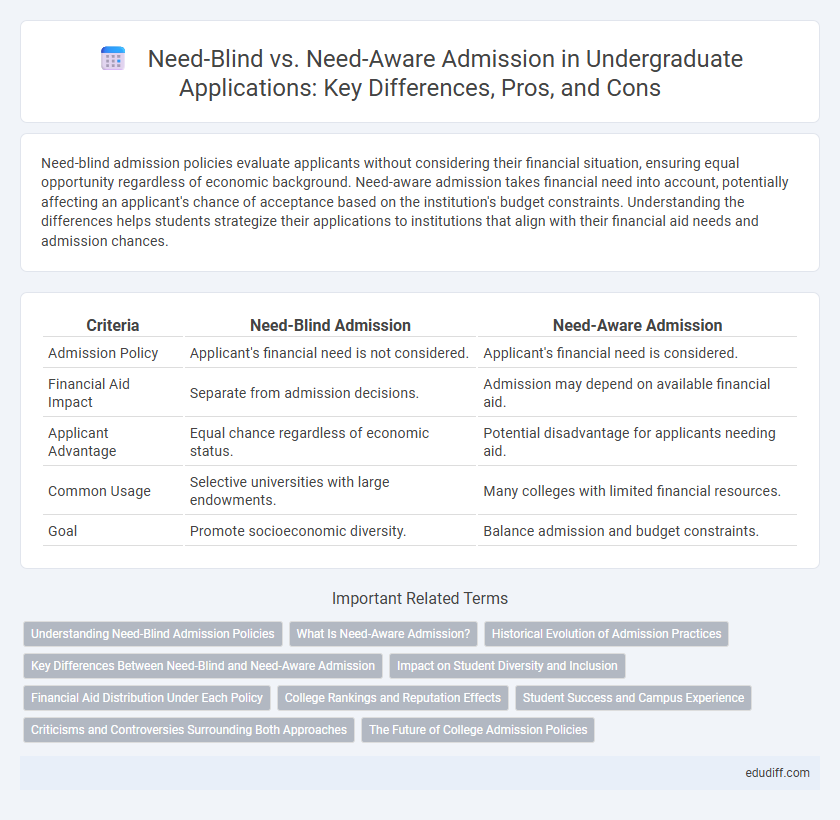Need-blind admission policies evaluate applicants without considering their financial situation, ensuring equal opportunity regardless of economic background. Need-aware admission takes financial need into account, potentially affecting an applicant's chance of acceptance based on the institution's budget constraints. Understanding the differences helps students strategize their applications to institutions that align with their financial aid needs and admission chances.
Table of Comparison
| Criteria | Need-Blind Admission | Need-Aware Admission |
|---|---|---|
| Admission Policy | Applicant's financial need is not considered. | Applicant's financial need is considered. |
| Financial Aid Impact | Separate from admission decisions. | Admission may depend on available financial aid. |
| Applicant Advantage | Equal chance regardless of economic status. | Potential disadvantage for applicants needing aid. |
| Common Usage | Selective universities with large endowments. | Many colleges with limited financial resources. |
| Goal | Promote socioeconomic diversity. | Balance admission and budget constraints. |
Understanding Need-Blind Admission Policies
Need-blind admission policies ensure that a student's financial situation does not influence the college's decision to admit, promoting equal opportunity regardless of economic background. These policies are predominantly seen in highly selective institutions that have substantial endowments to support financial aid. Understanding the distinction between need-blind and need-aware admissions is crucial for applicants navigating financial aid and acceptance chances.
What Is Need-Aware Admission?
Need-aware admission considers an applicant's financial need as a factor in the decision-making process, potentially affecting their chances of acceptance. Colleges using need-aware policies balance financial aid budgets by admitting students who can contribute to the institution's revenue. This approach contrasts with need-blind admission, where financial need does not influence admission outcomes.
Historical Evolution of Admission Practices
Colleges initially adopted need-aware admission policies, linking financial aid availability to admission decisions and often limiting access for lower-income applicants. The shift toward need-blind admission emerged prominently in the late 20th century, emphasizing equal consideration of all applicants regardless of financial need to promote diversity and equity. This historical evolution reflects changing societal values and increasing institutional commitment to accessible higher education.
Key Differences Between Need-Blind and Need-Aware Admission
Need-blind admission means colleges evaluate applicants without considering their financial need, promoting equal opportunity regardless of economic background. Need-aware admission incorporates financial need into the decision process, potentially impacting an applicant's chances of acceptance based on the institution's budget and enrollment goals. The key difference lies in whether financial need influences admission decisions, affecting diversity and accessibility at undergraduate institutions.
Impact on Student Diversity and Inclusion
Need-blind admission policies foster greater student diversity and inclusion by admitting candidates without considering their financial background, thereby increasing opportunities for underrepresented and low-income students. In contrast, need-aware admission may limit diversity by factoring in an applicant's financial need during decision-making, potentially disadvantaging economically challenged students. Studies indicate that universities with need-blind admissions typically report higher enrollment rates of first-generation college students and minority groups, promoting a more inclusive campus environment.
Financial Aid Distribution Under Each Policy
Need-blind admission policies do not consider an applicant's financial situation during the evaluation process, ensuring that financial aid is distributed based solely on demonstrated need after admission decisions. Conversely, need-aware admission policies take financial need into account, allowing institutions to allocate financial aid strategically to balance budgets while managing class composition. Under need-blind systems, financial aid budgets may be stretched thinner due to unpredictable demand, whereas need-aware policies enable more targeted and controlled distribution of limited aid resources.
College Rankings and Reputation Effects
Need-blind admission policies often enhance a college's reputation by attracting a diverse and qualified student body regardless of financial need, which can positively influence college rankings. In contrast, need-aware admission may limit accessibility for lower-income applicants, potentially impacting the perception of inclusivity and diversity that rankings increasingly value. Colleges with need-blind policies frequently benefit from higher rankings due to improved metrics on student selectivity, diversity, and alumni outcomes.
Student Success and Campus Experience
Need-blind admission prioritizes student success by admitting candidates without considering financial need, fostering a diverse campus where academic potential drives enrollment. This approach enhances campus experience by promoting inclusivity and reducing economic barriers, leading to a vibrant, engaged student body. Conversely, need-aware admission may limit access for some students based on financial aid availability, potentially impacting campus diversity and the overall richness of student interactions.
Criticisms and Controversies Surrounding Both Approaches
Need-blind admission policies face criticism for potentially favoring wealthy applicants, as schools may limit financial aid to maintain economic balance, thus disadvantaging low-income students. Need-aware admission, while transparent about financial considerations, is often contested for limiting access to talented but underprivileged applicants due to budget constraints. Both approaches spark controversies relating to equity, diversity, and the true commitment of institutions to socioeconomic inclusivity in undergraduate admissions.
The Future of College Admission Policies
Colleges are increasingly evaluating the long-term viability of need-blind admission due to rising tuition costs and limited financial aid budgets. Need-aware admission policies allow institutions to balance diversity and financial sustainability by considering an applicant's financial need during the decision process. The future of college admission likely involves hybrid models that aim to maintain accessibility while addressing economic challenges.
Need-Blind Admission vs Need-Aware Admission Infographic

 edudiff.com
edudiff.com